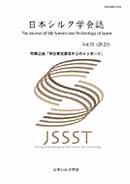Current issue
Displaying 1-15 of 15 articles from this issue
- |<
- <
- 1
- >
- >|
-
2023 Volume 31 Pages 5
Published: 2023
Released on J-STAGE: October 19, 2023
Download PDF (182K) -
2023 Volume 31 Pages 7-8
Published: 2023
Released on J-STAGE: October 19, 2023
Download PDF (948K) -
2023 Volume 31 Pages 9-12
Published: 2023
Released on J-STAGE: October 19, 2023
Download PDF (1763K) -
2023 Volume 31 Pages 13-15
Published: 2023
Released on J-STAGE: October 19, 2023
Download PDF (1316K) -
2023 Volume 31 Pages 17-20
Published: 2023
Released on J-STAGE: October 19, 2023
Download PDF (335K)
-
2023 Volume 31 Pages 21-26
Published: 2023
Released on J-STAGE: October 19, 2023
Download PDF (1072K) -
2023 Volume 31 Pages 27-33
Published: 2023
Released on J-STAGE: October 19, 2023
Download PDF (2676K) -
2023 Volume 31 Pages 35-40
Published: 2023
Released on J-STAGE: October 19, 2023
Download PDF (425K) -
2023 Volume 31 Pages 41-52
Published: 2023
Released on J-STAGE: October 19, 2023
Download PDF (3335K) -
2023 Volume 31 Pages 53-62
Published: 2023
Released on J-STAGE: October 19, 2023
Download PDF (1165K) -
2023 Volume 31 Pages 63-75
Published: 2023
Released on J-STAGE: October 19, 2023
Download PDF (1561K)
-
2023 Volume 31 Pages 77-81
Published: 2023
Released on J-STAGE: October 19, 2023
Download PDF (580K) -
2023 Volume 31 Pages 83-87
Published: 2023
Released on J-STAGE: October 19, 2023
Download PDF (588K)
-
2023 Volume 31 Pages 89-95
Published: 2023
Released on J-STAGE: October 19, 2023
Download PDF (479K)
-
2023 Volume 31 Pages 97-104
Published: 2023
Released on J-STAGE: October 19, 2023
Download PDF (5520K)
- |<
- <
- 1
- >
- >|
